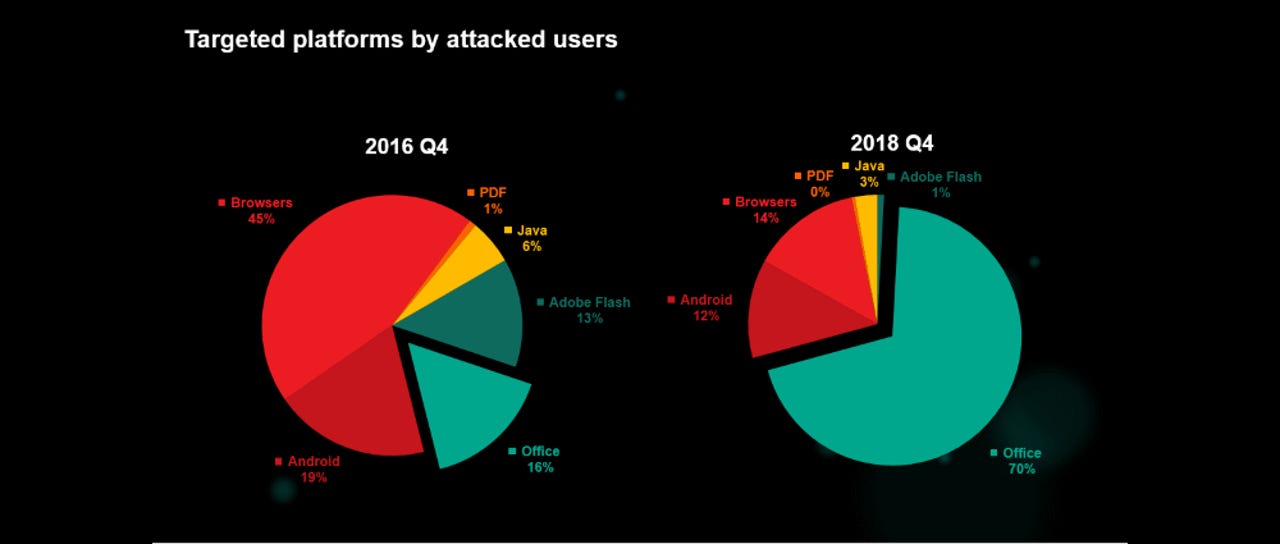Kaspersky: 70 percent of attacks now target Office vulnerabilities


Security
Microsoft Office products are today's top target for hackers, according to attack and exploitation data gathered by Kaspersky Lab.
In a presentation at its security conference --the Security Analyst Summit-- the company said that around 70 percent of the attacks its products have detected in Q4 2018 are trying to abuse a Microsoft Office vulnerability.
That's more than four times the percentage the company was seeing two years before, in Q4 2016, when Office vulnerabilities had accounted for a meager 16 percent.
Attacks target outdated Office components
"An interesting side note," Kaspersky said. "None of the top most exploited vulnerabilities are in MS Office itself. Rather, the vulnerabilities exist in related components."
For example, two of the most exploited vulnerabilities, CVE-2017-11882 and CVE-2018-0802, impact Office's legacy Equation Editor component.
"A look at the most exploited vulnerabilities of 2018 confirms exactly that: Malware authors prefer simple, logical bugs," the company said.
"That is why the equation editor vulnerabilities CVE-2017-11882 and CVE-2018-0802 are now the most exploited bugs in MS Office. Simply put, they are reliable and work in every version of Word released in the past 17 years," researchers said. "And, most important, building an exploit for either one requires no advanced skills."
Furthermore, even if the vulnerabilities don't impact Microsoft Office and its components directly, they are exploited via Office files.
For example, CVE-2018-8174 is a bug in the Windows VBScript engine, which the Office app also uses when processing Office documents.
A similar situation is also valid for CVE-2016-0189 and CVE-2018-8373, both vulnerabilities in the Internet Explorer scripting engine that can also be exploited via Office files --where IE's scripting engine is used to process web-based content.
The same conclusions from the Office Equation Editor attacks are also valid here. These vulnerabilities exploit components that have been used in Office for many years, and removing these components would devastate Office's backward compatibility.
Recorded Future saw similar things
Furthermore, another report released last month by security firm Recorded Future also gives credence to Kaspersky's recent findings.
In a report detailing the most exploited vulnerabilities in 2018, Recorded Future ranked six Office flaws in its Top 10.
#1, #3, #5, #6, #7, and #8 are Office flaws or vulnerabilities that can be exploited with the help of Office documents.
- CVE-2018-8174 – Microsoft (exploitable via Office files)
- CVE-2018-4878 – Adobe
- CVE-2017-11882 – Microsoft (Office flaw)
- CVE-2017-8750 – Microsoft
- CVE-2017-0199 – Microsoft (Office flaw)
- CVE-2016-0189 – Microsoft (exploitable via Office files)
- CVE-2017-8570 – Microsoft (Office flaw)
- CVE-2018-8373 – Microsoft (exploitable via Office files)
- CVE-2012-0158 – Microsoft
- CVE-2015-1805 – Google Android
Security research and PoCs are doing harm
Kaspersky said that one of the reasons why Office bugs often become the target of malware distribution campaigns is due to an entire crime ecosystem existing around it.
Once details about an Office vulnerability become public, an exploit for it appears on the dark market in a matter of days.
"Bugs themselves have become much less complex, and sometimes a detailed write-up is all a cybercriminal needs to build a working exploit," Kaspersky said.
This is the very same issue that ZDNet recently discussed with Leigh-Anne Galloway, cybersecurity resilience lead at Positive Technologies. Time and time again, the publication of proof-of-concept code for zero-days and recently patched security bugs often helped hackers more than it did securing end-users. More in our interview here.
Handy hardware for the home office
More vulnerability reports:
- Dragonblood vulnerabilities disclosed in WiFi WPA3 standard
- Tens of thousands of cars were left exposed to thieves due to a hardcoded password
- Adobe patch update squashes critical code execution bugs
- Internet Explorer zero-day lets hackers steal files from Windows PCs
- Microsoft's April Patch Tuesday comes with fixes for two Windows zero-days
- Some enterprise VPN apps store authentication/session cookies insecurely
- KRACK attack: Here's how companies are responding CNET
- Top 10 app vulnerabilities: Unpatched plugins and extensions dominate TechRepublic